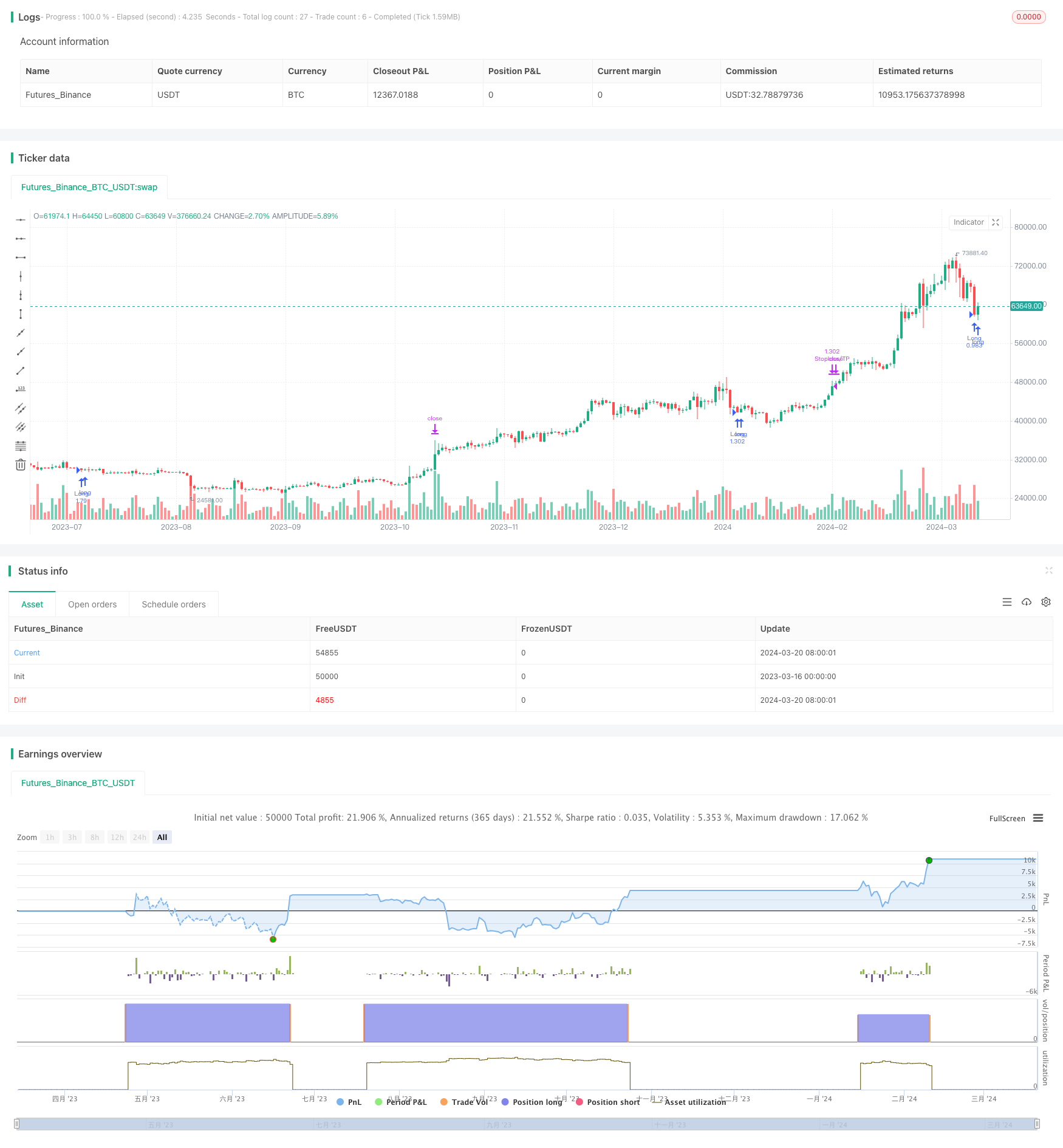
策略概述
Flawless Victory DCA 动量与波动率策略是一个基于动量指标RSI和波动率指标布林带,结合DCA(Dollar Cost Averaging,美元成本平均法)的量化交易策略。该策略旨在捕捉市场的动量和波动率,同时通过止损和止盈水平来管理风险。
策略原理
该策略使用两个技术指标:RSI和布林带。RSI是一个动量振荡指标,用于衡量价格变化的速度和变化幅度,策略中使用了长度为14的RSI。布林带是一个波动率指标,由一条简单移动平均线(SMA)和两条标准差曲线组成。
策略的主要逻辑如下:
- 当价格低于布林带下轨,且RSI高于超卖阈值(42)时,触发买入信号。
- 如果启用了DCA,且满足时间条件(每隔指定的小时数),则基于买入条件开仓做多。
- 当价格高于布林带上轨,且RSI高于超买阈值(70)时,触发卖出信号。
- 一旦满足卖出条件,策略将平掉多头仓位,并设置止损和止盈水平。
总的来说,该策略结合了RSI和布林带等技术指标以及DCA的条件逻辑,以进场、出场和潜在的美元成本平均法为基础。目标是利用市场的动量和波动率,同时通过止损和止盈水平来管理风险。
策略优势
- 结合动量和波动率:该策略综合考虑了市场的动量(通过RSI)和波动率(通过布林带),可以更全面地把握市场行情。
- 美元成本平均法:策略提供了DCA的选项,可以在价格下跌时逐步建仓,降低持仓成本。
- 风险管理:策略设置了明确的止损和止盈水平,有助于控制潜在的损失和锁定已实现的利润。
- 灵活的参数设置:策略提供了多个可调整的输入参数,如止损百分比、止盈百分比、DCA间隔等,可以根据不同的市场条件和风险偏好进行调整。
风险分析
- 参数敏感性:策略的表现可能对输入参数(如RSI阈值、布林带乘数等)较为敏感,不恰当的参数设置可能导致策略表现不佳。
- 市场条件变化:策略基于特定的技术指标,在某些市场条件下(如震荡市或趋势反转)可能无法很好地适应。
- 过度交易:如果DCA间隔设置过短,可能导致过度频繁的交易,增加交易成本并影响策略收益。
- 止损和止盈位置:止损和止盈水平的设置可能影响策略的整体表现,设置过紧可能导致过早止损,设置过松可能导致潜在利润的流失。
优化方向
- 参数优化:对策略的关键参数(如RSI阈值、布林带乘数、DCA间隔等)进行优化和敏感性分析,以找到最佳的参数组合。
- 加入其他指标:考虑加入其他技术指标(如MACD、ATR等)来提高信号的可靠性和稳健性。
- 动态止损和止盈:根据市场条件动态调整止损和止盈水平,如使用追踪止损(Trailing Stop)以保护利润。
- 加入市场环境过滤:根据市场环境(如趋势、震荡等)对策略进行过滤,以适应不同的市场状态。
- 资金管理优化:优化策略的资金管理规则,如根据风险调整后的收益率来确定仓位大小。
总结
Flawless Victory DCA 动量与波动率策略是一个结合动量指标RSI、波动率指标布林带以及DCA的量化交易策略。策略的主要优势在于综合考虑了市场的动量和波动率,提供了DCA的选项,并设有明确的风险管理措施(止损和止盈)。同时,策略也存在一些潜在的风险,如对参数设置的敏感性、对市场条件变化的适应性等。未来的优化方向可以包括参数优化、加入其他指标、动态止损止盈、市场环境过滤以及资金管理优化等。总的来说,Flawless Victory DCA 动量与波动率策略为量化交易提供了一个基于动量和波动率的思路,但在实际应用中还需要根据具体的市场条件和风险偏好进行适当的调整和优化。
策略源码
/*backtest
start: 2023-03-16 00:00:00
end: 2024-03-21 00:00:00
period: 1d
basePeriod: 1h
exchanges: [{"eid":"Futures_Binance","currency":"BTC_USDT"}]
*/
//FOR BUY STRATGY : @Suameer
//Create by zipix
//@version=4
strategy(overlay=true, shorttitle=" DCA Strategy", default_qty_type = strategy.percent_of_equity, initial_capital = 100000, default_qty_value = 100, pyramiding = 0, title="Flawless Victory DCA Strategy", currency = 'USD')
////////// ** Inputs ** //////////
// Stoploss and Profits Inputs
stoploss_input = input(6.604, title='Stop Loss %', type=input.float, minval=0.01)/100
takeprofit_input = input(2.328, title='Take Profit %', type=input.float, minval=0.01)/100
stoploss_level = strategy.position_avg_price * (1 - stoploss_input)
takeprofit_level = strategy.position_avg_price * (1 + takeprofit_input)
// DCA Settings
dca_enabled = input(false, title="Enable DCA")
dca_interval = input(1, title="DCA Interval (hours)", type=input.integer)
////////// ** Indicators ** //////////
// RSI
len = 14
src = close
up = rma(max(change(src), 0), len)
down = rma(-min(change(src), 0), len)
rsi = down == 0 ? 100 : up == 0 ? 0 : 100 - 100 / (1 + up / down)
// Bollinger Bands
length = 20
mult = 1.0
basis = sma(src, length)
dev = mult * stdev(src, length)
upper = basis + dev
lower = basis - dev
////////// ** Triggers and Guards ** //////////
// Strategy Parameters
RSILowerLevel = 42
RSIUpperLevel = 70
BBBuyTrigger = src < lower
BBSellTrigger = src > upper
rsiBuyGuard = rsi > RSILowerLevel
rsiSellGuard = rsi > RSIUpperLevel
//////////** Strategy Signals ** //////////
// Entry Condition
buy_condition = BBBuyTrigger and rsiBuyGuard
// DCA Logic
if dca_enabled and (hour % dca_interval == 0)
strategy.entry("DCA Long", strategy.long, when = buy_condition, alert_message = "DCA - Buy Signal!")
else
strategy.entry("Long", strategy.long, when = buy_condition, alert_message = "Buy Signal!")
// Exit Condition
sell_condition = BBSellTrigger and rsiSellGuard
strategy.exit("Stoploss/TP", "Long", stop = stoploss_level, limit = takeprofit_level, when = sell_condition, alert_message = "Sell Signal!")